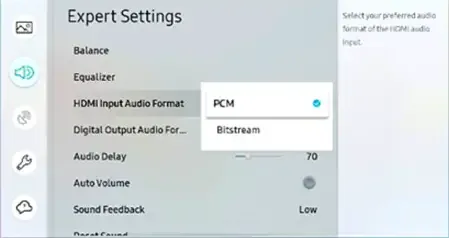HDMI Input Audio Format Bitstream Or PCM
When we select HDMI Input Audio, is it Bitstream or PCM? What do we have to choose? In our comprehensive analysis of the selection of PCM or Bitstream, we had many questions in the comments about what specifically applies to a Samsung TV and what is different in the selection for PCM or Bitstream than other devices.
Now, I think that we have to go further because this Bitstream or PCM whole thing on Samsung TV devices applies when you are utilizing the Samsung proprietary HDMI Input Audio Format, which we capitalize here as it is a Samsung patent.
In the discussion Bitstream or PCM for the HDMI Input Audio Format setting, you should generally select Bitstream if you have an external device connected through HDMI technology which has multichannel audio of minimum a 2.1 fixture. Otherwise, PCM will enable only a standard 2.0 left and right fixture.
PCM or Bitstream For The Samsung TV Through The HDMI Input Audio Format
This only applies when you connect an external device to your Samsung TV through HDMI architecture that is handled by Samsung through HDMI Input Audio Format. Otherwise, this setting does not apply to you.
HDMIs are, nevertheless, very common, and here we have used them in reviews of PC monitors, cable and satellite boxes, and home theater receivers to name a few.
To configure the input audio for your Samsung TV, go to the TV’s Settings menu, then pick Sound, and finally select “Expert Settings” from the drop-down menu that appears. After this, click on the HDMI Input Audio Format option, and then simply choose either PCM or bitstream from the list of supported audio formats, as seen in the image below.

So which one to use? First, let´s see when to select PCM and then when to select Bitstream for the HDMI Input Audio Format setting.
PCM stands for “pulse-code modulation,” whereas bitstream refers to the audio format used by Samsung TVs. You should make use of this option if the sound has already been processed by the external device that you have attached to the HDMI connection, and all you want is for it to come out of the speakers on your TV.
PCM must be utilized if the incoming soundtrack was handled by the external gear linked through HDMI and you just require this sound to be heard through the internal speakers of the Samsung TV.
This is a common setup and is typical with receivers and the PS5, wherein the sound is processed in the external device and released later in a loudspeaker, soundbar, or internal speakers, according to your settings.

This Samsung TV setup modifies the signaling to a 2.0 PCM pattern as it travels through the television. If you pick PCM when a, for example, home theater system or soundbar is attached, the sound system will only retrieve 2.0-channel sound, even if the sound system is well capable of multi-channel PCM audio.
The result will not be multi-channel surround sound. It will be 2.0. An audio channel pattern of 2.0 means just two channels: left and right, which is just right for how mammals hear: a binaural hearing pattern to identify where sounds come from and accelerate any defensive response.
However, here in Planet HiFi, we are generally recommending a 2.1 fixture (in soundbars, at least) which is left and right channels, plus a separate subwoofer.
So in those cases, just do not select PCM because you would lose this advantageous 2.1 channel fixture that, for example, soundbars provide.
Now let´s see when to select Bitstream for this HDMI Input Audio Format, right below:
So, using the same reasoning as above for PCM, Bitstream should be selected whenever the soundtrack is processed by a device after it passes through the TV, like when you have a soundbar.
If Bitstream is selected and neither a loudspeaker system nor a soundbar is attached, the Samsung TV will process and broadcast the audio. This may often result in diminished loudness or other degraded audio quality. I advise picking PCM while utilizing the television’s speakers.
Despite the aforementioned statement, I have not detected in my ears any distortion in the sound output. At very low levels, human ears cannot detect some differences in Total Harmonic Distortion. Maybe your dog can…..
So, please allow me to conclude this topic, Bitstream will be necessary for the HDMI Input Audio Format setting when you have a multichannel surround sound fixture in your home theater architecture or use a multichannel soundbar, so you enjoy a minimum of 2.1 fixture instead of a standard 2.0 fixture.

I am Bob. I work as an audio engineer and audio technician. I work in mastering and arranging bridges in existing songs and the arrangement and orchestration of the chorus. In Planet HiFi I test gear for a couple of days and write a review. I also write about AV topics, amplifiers, speakers, and headphones.

